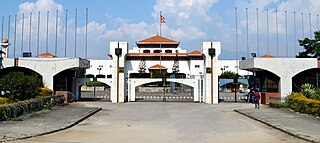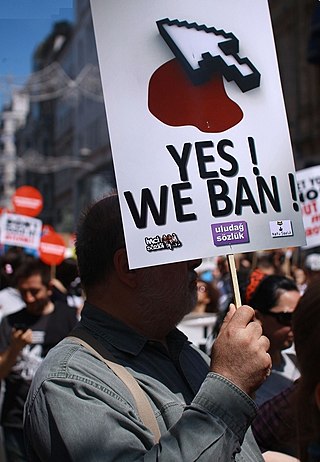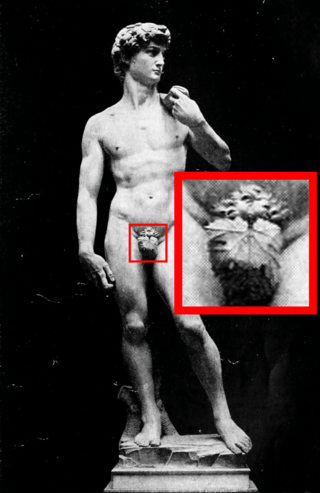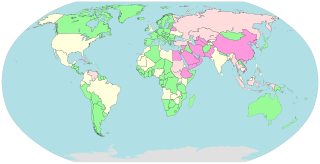The Constitution of Nepal guarantees the freedom of expression in media; media should not be subject to direct censorship. In 2012, International Mission acknowledges that the progressive media policy in Nepal to follow the constitution is necessary, as the Ministry of Information and Communications (Nepal) has published a draft Media Policy on its website. [2] The media, however, were still limited only in capital, and it was hard to find the access outside the capital. Moreover, the government approved the Online Media Directives 2015 without any hesitation, while it provides censorship or shut-down online media within their contents, which denies the Constitution. [3] As a result, the government-owned media disseminate information to public and causes the disbelief in mass media. [4]
Press
According to the Article 115 of the 1990 Constitution, any form of censorship was outlawed, and a free press was strongly guaranteed with announcement of parliamentary democracy. [5] Unfortunately, press media was heavily censored in 2001 and 2002 by the king Gyanendra Bir Bikram Shah Dev, unlike he promised. The king implemented Clause 1 of Article 115 of the 1990 constitution to suspend the guaranteed freedom of thought and expression that banned censorship. [6] As a result, in 2002, hundreds or maybe even thousands of journalists who indicated their political opinions on the media were arrested, beaten, or detained, and some of them were killed to fight for freedom of expression guaranteed in the constitution. [7]
In 2006, massive protests occurred to force the king to realize parliamentary democracy, and this resulted in returning some of fundamental press freedom. Until now, the government has not solved instability of censorship of media and creates norms and fragile democratic structures. The Nepal Press Council and the Federation of Nepali Journalists (FNJ) have a code of conduct, but it lacks effective systems and mechanisms, and it needs more support from media stakeholders. [8]
Internet
The government controls the Internet in Nepal. The international internet connections were cut off by the government due to the martial law declared by the King in 2005. [9] Self censorship can be forced on internet content by intimidation as happened in the case of a satirical folk song Lutna Sake Lut, which was taken down from YouTube by the author amid threats to his person. [10] [11]
On Nov 13th, 2023, authority announced TikTok ban in Nepal for its "disruption of the social harmony". [12] [13]
Film
The Film Censor Board was established in 1951 to work as a machinery of state control. [14] It mainly controls sex, violence, and politics in film and commands to cut off the scenes harmful to the society and the state. It also discredits the certification of prohibited movies if the whole cinema is assumed to be inappropriate for the state and society. For those of sexual scenes in movies are usually removed in chunks, and this censorship often causes low cinematic values with clumsiness and lacks completeness of movies. [15]
China censors both the publishing and viewing of online material. Many controversial events are censored from news coverage, preventing many Chinese citizens from knowing about the actions of their government, and severely restricting freedom of the press. China's censorship includes the complete blockage of various websites, apps, video games, inspiring the policy's nickname, the "Great Firewall of China", which blocks websites. Methods used to block websites and pages include DNS spoofing, blocking access to IP addresses, analyzing and filtering URLs, packet inspection, and resetting connections.
Censorship in South Korea is implemented by various laws that were included in the constitution as well as acts passed by the National Assembly over the decades since 1948. These include the National Security Act, whereby the government may limit the expression of ideas that it perceives "praise or incite the activities of anti-state individuals or groups". Censorship was particularly severe during the country's authoritarian era, with freedom of expression being non-existent, which lasted from 1948 to 1993.

The Nepalese democracy movement was the combination of a series of political initiatives and movements from the 20th century to 2008 that advocated the establishment of representative democracy, a multi-party political system and the abolition of monarchy in Nepal. It has seen three major movements, the Revolution of 1951, Jana Andolan and Loktantra Andolan which ultimately abolished the Shah monarchy, transitioned Nepal towards a republic and reintroduced multi-party bicameral democracy.
The Pakistani Constitution limits Censorship in Pakistan, but allows "reasonable restrictions in the interests of the sovereignty and integrity of Pakistan or public order or morality". Press freedom in Pakistan is limited by official censorship that restricts critical reporting and by the high level of violence against journalists. The armed forces, the judiciary, and religion are topics that frequently attract the government's attention.
Censorship in India has taken various forms throughout its history. Although de jure the Constitution of India guarantees freedom of expression, de facto there are various restrictions on content, with an official view towards "maintaining communal and religious harmony", given the history of communal tension in the nation. According to the Information Technology Rules 2011, objectionable content includes anything that "threatens the unity, integrity, defence, security or sovereignty of India, friendly relations with foreign states or public order".
Censorship in Bhutan refers to the way in which the Government of Bhutan controls information within its borders. There are no laws that either guarantee citizens' right to information or explicitly structure a censorship scheme. However, censorship in Bhutan is still conducted by restrictions on the ownership of media outlets, licensing of journalists, and the blocking of websites.
Germany has taken many forms throughout the history of censorship in the country. Various regimes have restricted the press, cinema, literature, and other entertainment venues. In contemporary Germany, the Grundgesetz generally guarantees freedom of press, speech, and opinion.
The Federal Republic of Germany guarantees freedom of speech, expression, and opinion to its citizens as per Article 5 of the constitution. Despite this, censorship of various materials has taken place since the Allied occupation after World War II and continues to take place in Germany in various forms due to a limiting provision in Article 5, Paragraph 2 of the constitution. In 2014 the Reporters Without Borders Press Freedom Index ranked Germany as 14th in the world in terms of press freedom. During the Allied occupation of Germany, the media was controlled by the occupying forces. The policy rationales differed among the occupying powers, but there was resentment in literary and journalistic circles in many parts of the country. Undesired publishing efforts were unilaterally blocked by the occupying forces.
Censorship in Myanmar results from government policies in controlling and regulating certain information, particularly on religious, ethnic, political, and moral grounds.

Censorship in Turkey is regulated by domestic and international legislation, the latter taking precedence over domestic law, according to Article 90 of the Constitution of Turkey.
Although in 2011 only about 9.0% percent of Nepal's population used the Internet, use of the Internet in Nepal is growing rapidly. As of July 2021, 90.56% of the population has access to the Internet according to Nepal Telecommunications Authority (NTA).
The print, broadcast and online mass media in Burma has undergone strict censorship and regulation since the 1962 Burmese coup d'état. The constitution provides for freedom of speech and the press; however, the government prohibits the exercise of these rights in practice. Reporters Without Borders ranked Burma 174th out of 178 in its 2010 Press Freedom Index, ahead of just Iran, Turkmenistan, North Korea, and Eritrea. In 2015, Burma moved up to 144th place, ahead of many of its ASEAN neighbours such as Singapore, as a result of political changes in the country.

Censorship is the suppression of speech, public communication, or other information. This may be done on the basis that such material is considered objectionable, harmful, sensitive, or "inconvenient". Censorship can be conducted by governments, private institutions, and other controlling bodies.

Human rights in Zambia are addressed in Zambia's constitution. However, the Zambia 2012 Human Rights Report of the United States Department of State noted that in general, the government's human rights record remained poor. The 2021 version of this report noted improvements in many areas.
Mass media regulations are a form of media policy with rules enforced by the jurisdiction of law. Guidelines for media use differ across the world. This regulation, via law, rules or procedures, can have various goals, for example intervention to protect a stated "public interest", or encouraging competition and an effective media market, or establishing common technical standards.
In Nigeria, the freedom of expression is protected by section 39 (1) of the Federal Republic of Nigeria constitution. Despite this constitutional protection, the Nigerian media was controlled by the government throughout much of its history, with some even to this day. By 2020, however, over 100 newspapers in Nigeria were independent. Furthermore, there was a brief moment from 1979 to 1983 when the government of the Second Nigerian Republic handed over the task of censorship to the military. Nigerian censors typically target certain kinds of idea, such as ethnic discussion, political opposition, and morality incorrectness.

South Korea is considered to have freedom of the press, but it is subject to several pressures. It has improved since South Korea transitioned to democracy in the late 20th century, but declined slightly in the 2010s. Freedom House Freedom of the Press has classified South Korean press as free from 2002 to 2010, and as partly free since 2011.

The freedom of the press in Spain, a constitutional monarchy with a parliamentary democracy, is guaranteed in section 20 of its constitution written in 1978, after the 1975 end of the dictatorship of General Francisco Franco. Spain was ranked at 29th place in the World Press Freedom Index in 2017.

This list of Internet censorship and surveillance in Africa provides information on the types and levels of Internet censorship and surveillance that is occurring in countries in Africa.
Since the end of the Rwandan Civil War, many forms of censorship have been implemented in Rwanda.







